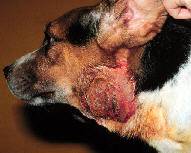|
|
 |
| Large hot spot near ear |
|
A hot spot is a superficial skin infection that results when the normal
skin bacteria overrun the skins defenses as a result of damage to the skin
surface. This is most often started by the dog chewing or scratching at
the site. In the first stages of the formation of a hot spot, the skin
becomes moist, inflamed (red), pruritic (itchy), and infected. Pus oozes
from the damaged skin as bacterial infection sets in. The dried pus and
damaged skin surface from the infection will form a tightly-adhered crust,
and the dog will lose hair over the infection site. Frequently, dogs show
pain when the site is touched at this stage.
Hot spots can enlarge rapidly, so early diagnosis ? before your pets hot spot involves a large area of the body -- is important. Both dogs and cats can get hot spots, although dogs with dense undercoats are more likely to develop the problem than smooth-coated dogs or cats are. Hot spots are more common during hot, humid weather, but can occur year-round, depending on the inciting cause.
Causes
Anything that creates irritation to the skin, causing the pet to chew or scratch at the site, can cause a hot spot. Insect (flea/fly/etc.) bites, allergies, excess skin-surface moisture, heavy/dense hair coats, matted hair, skin scrapes, etc. Saliva accumulation under a hair coat, as a result of the itchy pet chewing on himself, can result in hot spots. Dogs and cats always have a bacterium near the mouth called Staphylococcus intermedius. This type of Staph, not usually at all contagious to people, is the most common infection found in hot spots.
The location of the hot spots may help your veterinarian determine the underlying cause of the problem. A hot spot over the hip could indicate flea infestation, hip arthritis, anal gland infection, etc., just as a hot spot near an ear could indicate an ear problem, allergy/dental/nerve irritation, etc.
Treatment
The first step your veterinarian will take is to clip or shave and clean the inflamed/infected area to allow the air to get to it. (Moisture and pus trapped on the skin makes the hot spot worse.) Clipping and cleaning will allow your veterinarian to see how large the inflamed area is. Hot spots can be painful, so sedation or anesthesia may be necessary in order to shave and clean the spot properly. Your veterinarian may need to perform cytology or culture the hot spot, to determine the best antibiotic to use during the treatment phase.
Treatment may involve antibiotics (topical and/or systemic, either oral or injectable); anti-inflammatory drugs (NSAIDs); glucocorticoids (steroids to reduce itchiness, pain, and swelling); topical medications; or e-collars or similar collars to prevent your pet from bothering the infected area.
The treatment your veterinarian chooses will depend on how bad the problem is, how much pain the animal is in, how long the problem has been going on, and if the problem is a recurring one. Some pets may get one or two hot spots and then never get another one again, while some pets may have frequent recurrences.

|

